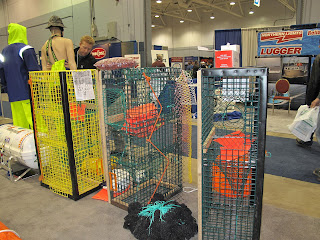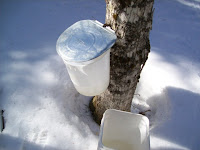I grew up in Quebec, where maple syrup is part of the culture and maple sugaring, an annual rite of passage into spring. Sugar shacks, with their sweet steaminess and smell of woodsmoke, always evoked things close to my heart: a connection to the land and Nature, and intimacy with their seasons and secrets; and the straightforward honesty of a simple way of life where hard work produces sweet rewards.
Yes, I am a dreamer at heart. But as a Montrealer, sugar shacks were places I only got to visit; I could look but not touch. Consequently, I've always longed to participate in the annual sugaring process... and this year, it's finally happening.
Meet Jean-Marc Fiset. He and his wife, Linda, live at the other end of West Quaco Road, where it meets Highway 111. Jean-Marc came here from Quebec as a young man, and met and married Linda. They moved to Quebec, raised their family, then returned here for "retirement". At 67, Jean-Marc still works as an electrician and house painter (exteriors only, he insists). And every spring, he makes syrup.
I learned about Jean-Marc from seeing the photos of last year's sugaring on Bill Hall's Facebook. Bill doesn't go anywhere without his camera, so his life gets chronicled in regular Facebook posts. Some people in the village duck when they see his camera come out of his pocket, shy about having their picture appear online. Bill's a pretty good photographer most of the time, and credit for some of the photos in this post goes to him. As there are going to be so many photos in this post, I'm keeping most of them small... but you can see more detail by clicking on them, then using your "back" button to get back to the blog.
Anyway, Jean-Marc didn't know that I followed Bill's Facebook posts before coming here. Therefore, when he came to my house to install some new phone jacks a few days after I arrived, he was some surprised when I exclaimed, "You're the man who does the maple sugaring! Next spring, I want to help."

Jean-Marc is salt-of-the-earth, so when spring appeared on the horizon this year, I got my wish. We (Jean-Marc, Bill, Brian and I) started tapping a couple of weeks ago, when the temperatures at night were still below freezing but the days were warm and sunny. Although the snow was long gone from my yard, there was still two or three feet of it in the bush, about 15 minutes drive inland. It had a firm, icy crust, so you could walk without breaking through. The air was crisp, the sky clear, yet the creek was alive with meltwater. Jean-Marc drilled the holes and tapped in the spouts, while the rest of us hung about 120 buckets and lids.

You tap on the south side of a tree, where the sun will heat things up and get the sap running. If the tree was tapped previously, you stay at least four inches away from the old hole, because the tree will have formed a brownish scar tissue around it, which will colour the sap. Depending on the size of the tree, you can have more than one tap. On a few of the biggest trees, Jean-Marc used a smaller plastic spigots with plastic hoses that were draped into a bucket hanging from a regular metal spigot. You don't tap trees smaller than six inches diameter, which would be kind of like taking candy from a baby; they need their sap to grow big and strong.

Occasionally, I caught Jean-Marc peering intently up at the tops of the trees. Since this was a mixed hardwood woodlot, sometimes it was hard to tell which were maples by the bark alone. Did you know that you can identify a maple by the tips of its smallest branches? They end in a single twig, no side branches, with a pointed bud. That's what he was looking at.

There was much improvisation evident in Jean-Marc's supplies. He has only a few of the typical metal sap buckets that you often see in pictures. The remaining buckets are recycled plastic ones of various shapes and sizes, with a hole for hanging cut out near the rim. Many of the lids are made from recycled election signs, cut up and put to useful purpose. I had always assumed that the lids were for keeping dirt out, but no, they're for protection from rain. The sap is already dilute enough that you don't want any extra water in it. Did you know that it takes approximately 40 gallons of sap to make a gallon of syrup? In fact, Jean-Marc doesn't use the word "sap"; he refers to it as "water". Here's what it looks like fresh from the tree:
So, a couple of days after setting up the taps, we went out to collect the water. The technique is simple: you carry a bucket from tree to tree, dumping the buckets on the trees into the one you're carrying.
When it's full, you dump your bucket into a larger container strapped to the ATV (or the horse-drawn sledge, as it would have been in the olden days). Here again, improvisation was evident: funnels made from a cut-down five-gallon water bottle and an inverted, orange, highway marker cone; plastic milk cans and a white plastic 45-gallon drum on a home-made, made-to-fit trailer.
It was the best of late winter experiences. Fresh air and the smell of wet leaves, warm sun and blue skies, the ping of sap hitting the bottom of freshly-emptied pails, the distant knocking of a woodpecker, the rustle as snowmelt converged into streamlets. I savoured every moment.
We go out every two or three days to collect more water. After the last outing a couple of days ago, the 45-gallon drum was only one third full, so things have really slowed down. It all depends on the weather, and lately the temperatures have been above zero at night. If that pattern holds, it will have been a short but intense season.


You can't hold onto the water very long or it will spoil, so Jean-Marc began the process of boiling it down right away, in the tiny sugar shack addition on his garage. The stove is home-built. It has a small firebox for small, hot fires, and a cut-down fuel oil tank welded on the back that tapers toward the chimney. That way, there's enough heated surface for four evaporator pans. The water goes into the one closest to the chimney and gets scooped from one pan into the next as it boils down and darkens. There's never more than an inch or two of liquid in the pans at a time, except for the last and smallest one, directly over the firebox, where the final cooking produces syrup.

Jean-Marc watches closely, monitoring, scooping, pouring. Although the pictures and improvised gear make the process look a bit rough-and-ready, this is actually a precision operation and Jean-Marc's experience and care are evident. He hangs a thick cloth cone in the steam, warming it to be ready when the syrup's done. As the moment approaches, the syrup bubbles frothily and starts to rise up in the pan.


At this point, seconds begin to count. Jean-Marc places the heavy filter, plus thinner ones inside and outside of it, into a large metal syrup can. He dons a heavy leather apron and gloves, and the scooping and pouring begin in earnest.
In the beaker is a large and carefully calibrated thermometer. He's watching for the syrup to exactly meet the red line, at which point it's perfectly cooked. If it's under, he waits a few seconds then tries again; if it's over, more liquid gets added from the adjacent pan and he waits a few minutes before trying again.

When the exact moment arrives, he whisks the evaporator pan off the stove and pours the syrup through the filters into the can. Then, the bottles (previously sterilized) go into pans of hot water over the firebox, to heat. The bottles and lids need to be warm when the hot syrup goes into them so that, as both cool down, the lids will seal properly. While he waits for the syrup to filter, Jean-Marc scoops liquid along from one evaporator pan into the next and adds new water to the first pan in line. The filtering doesn't take long... and the bottling begins. The small scale of the operation means there's only a few bottles at a time to fill.
Behold the finished product! This year, for reasons known only to Nature, spring has come early and fast, and the trees produced sap copiously for a short time (and will produce longer, we're keeping our fingers crossed). The resulting syrup is light and fine in texture, with a delicate yet clear flavour; grade AA, the champagne of maple syrups.
What a thrill!














































